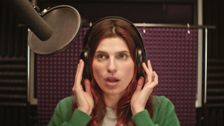I’ve seen plenty of documentaries about musicians, some very good—usually you get a biography of the subject; interviews with friends, colleagues, and others; and of course performances. But there’s a movie I watched recently called Rewind & Play, featuring the great jazz pianist Thelonious Monk, and it’s unlike anything I’ve seen before.
Monk was a brilliantly innovative composer and performer from the 1930s on, highly regarded by fellow musicians but not one of the big names in jazz, until his albums finally started selling in the ‘60s. In 1969, after a European tour, he was interviewed in Paris for a TV show.
Now, all these years later, and with Monk having died in 1982, the Senegalese-French director Alain Gomis dug into the archives of this French TV series called “Jazz Portrait,” and found all the rushes and unseen outtakes from the interview with Monk. It is his edit of this footage that constitutes the film Rewind & Play. None of this background information is fully explained in the movie—only gradually can we understand the nature of what we’re watching.
We see Monk arriving by plane in the city with his wife Nelly and an entourage. We watch them talking in the back of the car that’s taking them to the studio. They stop at what appears to be a Paris bar, and everybody continues to talk while Monk looks thoughtful, smoking cigarettes and having a drink. With his beret and goatee-style beard, he is unmistakable, but he hardly does any talking. Your usual film might’ve cut all this, but Gomis keeps all the footage in, and the effect is kind of strange. Monk is like an island of quiet stillness in the midst of noise. He smiles while staring dreamily into space. We wonder why he seems so distant, as if he’s in some other reality, not paying much attention to this one.
This puzzling effect continues when they arrive at the studio. There’s a piano, and people setting up all the lighting for the interview, but Monk isn’t yet being told what’s going on or what to do. Eventually he just sits down and starts playing. And as he plays in his distinctive improvisatory style, with this amazing sound flowing out from his fingers on the keyboard, we realize that *this* is his reality, his beautiful world—the music is where his mind and spirit have been living inside of him, and only now do we know who he is.
Then the interview begins. The host, Henri Renaud, asks questions that try to simplify Monk for a mainstream French audience. But Monk is unable to play along. He smiles in apparent disbelief as Renaud tries to get him to describe his marriage, why he put a piano in his kitchen, and why people didn’t seem to understand his music on the first tour in Paris in 1954. The answers he manages to give are not considered interesting enough, and so they keep reshooting the questions while Monk gets more and more restless. In hindsight it’s funny, because obviously Renaud, who claims to be a friend of Monk, doesn’t really get him at all. But at the time it was clearly uncomfortable, as the artist’s intense involvement in his music prevented him from engaging with such a superficial approach.
We feel relieved when Monk finally plays again, and we are transported once more into his amazing inner realm. Rewind & Play lets us experience the vast gulf between our normal critical mind and the unexplainable truth of creation.

Hal Ashby’s film about two navy men assigned to escort a young sailor to the brig, is an example of how gritty, downbeat films...

A day in the life of an abused young girl, presented by director Robert Bresson as the epitome of unjust human suffering. In the...

In a World…, the name of the first film written and directed by actress Lake Bell, refers to a famous opening line, used over...